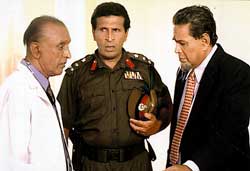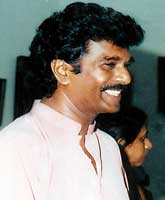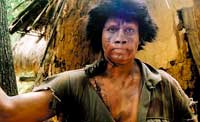
Surrealism and Prosthetic in ‘Antharjana Minisa’Compaigning to promote "surrealism" in Sri Lankan arts and "prosthetic" in the art of makeup, internationally qualified make up artist, actor, painter, poet, playwright, lecture and now a teledrama maker, Jayantha Ranawaka is to bring a novel experience to television audiences with his maiden miniplay ‘Antharjana Minisa’. The teledrama with a novel theme touches on a variety of areas like intellectual piracy and the difficulties faced by innovative directors specially those who attempt new approaches to the arts.
The dictionary defines 'surrealism' as a 20th-century literary and artistic movement that attempts to express the workings of the subconscious and is characterized by fantastic imagery and incongruous juxtaposition of subject matter. "Surrealism is not something new to us. In Buddhist literature we are taught that Lord Buddha walked as soon as he was born and seven lotuses blossomed along his path. Jathaka Katha is full of surrealistic stories and surrealism exists in our own literature though we haven't identified it," Jayantha Ranawaka said giving an introduction to our talk with him. Having excelled in his chosen fields like painting and makeup art, Ranawaka's journey in search of knowledge found him a new approach to arts with 'surrealism'. "It changed my outlook on life and art and I became a changed man," says Ranawaka contented with his discovery. And his first attempt on moving visual art is a 27 episode teledrama, "Antharjana Minisa". First steps in Prosthetic Ajantha came across the idea about "Antharjana Minisa" in the early 1980s and he made the blueprint for the silver screen titled 'Adisi Minisa' or 'Ex-Man'. A group of friends including late Vijaya Kumaratnge were beside him by then but unfortunately he failed in his initial attempt for the mere reason that he did not know how to create the characters representing the four stages of prehistoric man. 'So I decided to study the art of prosthetic' he said. Graduating from the Academy of Makeup Art and Technology in the United States, Ranawaka also got an opportunity to work in the lab where prosthetic characters of prehistoric animals were created for Steven Spielberg's 'Jurassic Park'. Returning to Sri Lanka Jayantha joined in creative works in both stage and cinema including one episode teledram series "Baawana" (1998), Thumindu Dodenthenna's play "Rhinoceros" (2003) and film "Rankevita" (2005) in which he created 'Pansal Yaka" using prosthetic. "In all these instances I was able to use what I studied creatively," says Jayantha who won awards for his mastery in makeup-art. Speaking about the problems in the medium of arts Ranawaka says, "The biggest paralysis in our medium of arts is that artists fail to be creative and reluctant to study what they do. The result of this is stagnation and worst is that they dish out low quality products for the market which have no depth at all,". For example this prosthetic make up art which was introduced to the world in 1930 to create the character of Frankenstein is not studied even today. 'Television is not merely a medium of cheap entertainment or a medium to sell viewers precious time for advertisement. 'Television has to play a more important role and it has a more responsible role to play in leading society to develop its own culture and tradition, Ranawaka says.
|
|| Front
Page | News | Editorial | Columns | Sports | Plus | Financial
Times | International | Mirror | TV
Times | Funday
Times || |
| |
Reproduction of articles permitted when used without any alterations to contents and the source. |
© Copyright
2007 | Wijeya
Newspapers Ltd.Colombo. Sri Lanka. All Rights Reserved. |



